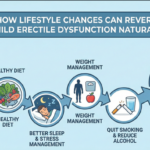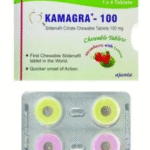Quantifying low sexual desire in healthy men and women presents significant challenges. The yearning for sexual intimacy varies greatly among individuals. Hypoactive Sexual Desire Disorder (HSDD) impacts millions worldwide and is arguably one of the most overlooked and distressing sexual disorders. Numerous studies have been undertaken to comprehend and address HSDD effectively. Regrettably, the treatment approaches for HSDD often mistakenly focus on erectile dysfunction, resulting in substantial difficulties within couples’ relationships. Consequently, many individuals continue to endure this condition, leading to a lack of fulfilling sexual experiences.
Thank you for reading this post, don't forget to subscribe!“VIAGRAVATION”
Following the success of phosphodiesterase type 5 inhibitors, numerous men have been able to achieve firm and lasting erections during sexual intercourse. Thanks to Kamagra. However, these medications do not enhance libido, leading to a lack of interest in sexual activity. Consequently, individuals may find themselves desiring a more passionate and enjoyable sexual experience, even when they can achieve an erection. The term “Viagravation” refers to the frustration stemming from low libido and insufficient psychological and physiological drive to engage in sexual activity. This situation often results in significant dissatisfaction and frustration for their partners.
CONCEPTS OF SEXUAL DESIRE
To date, the intricate nature of sexual desire remains poorly understood by many. According to linear theory, “sexual thoughts and fantasies, along with an inherent drive to experience sexual tension and its release, serve as indicators of desire.” It is further asserted that “the individual experience of lustful desire in both partners must occur before any sexual engagement can take place.”
In practice, we observe variations in how partners experience sexual desire, particularly regarding its frequency and timing. Engaging in sexual activity is not solely motivated by pleasure; often, partners may participate in sex to satisfy their partner, alleviate boredom, obtain material benefits, or fulfill other personal motivations. This phenomenon is referred to as “receptive sexual desire,” which contrasts with “active sexual desire.”
HYPOACTIVE SEXUAL DESIRE
Hypoactive sexual desire disorder (HSDD) is characterized by a persistent or progressive lack of sexual fantasies and desire for sexual activity, which can significantly impact sexual function. Determining the precise prevalence of this disorder among men and women is challenging. According to research, the estimated range is between 0% and 15%. However, this figure is likely underestimated, as many individuals do not reveal their experiences unless specifically prompted by healthcare professionals.
The evaluation of low libido typically involves healthcare providers asking both direct and indirect questions to patients. Additionally, insights may be gathered through discussions with the patient’s partner to compile necessary information for thorough analysis and conclusions.
HSDD arises from a combination of biological and psychological factors. Contributing elements include advancing age and chronic illnesses such as AIDS, renal failure, and heart disease. Furthermore, some men, particularly bodybuilders with eating disorders, may also experience reduced libido. Various psychiatric conditions, including depression, anger, anxiety, and stress, can also adversely affect sexual desire.
STUDY: DESIRE IN DNA
For a considerable time, it has been believed that the sexual desire of both men and women is influenced by psychological and hormonal elements. Nevertheless, there has been no empirical evidence or research to support this notion. A recent study published in Molecular Psychiatry (Ebstein RP 2006) indicated that self-reported low libido may be linked to a variant in the gene known as the D4 receptor. This suggests that a lack of sexual desire could be regarded as a normal biological factor. Further research is necessary before this study can gain acceptance within the medical community.
Hormonal Etiologies
The relationship between hormones and low sexual desire is intricate. It is generally recognized that diminished sexual desire in men is primarily linked to a decline in testosterone levels, which can occur due to aging and various other factors. A similar phenomenon is observed in postmenopausal women. In men, testosterone is produced in response to luteinizing hormone (LH), which prompts the testes to secrete this hormone. While the testes are the main source of testosterone, the adrenal glands also contribute in certain instances.
Testosterone is crucial for the development during puberty and the secretion of pituitary gonadotropins. Additionally, it regulates cGMP (cyclic guanosine monophosphate) via nitric oxide synthase, which is essential for achieving a firm and robust erection. On average, men produce approximately 5 grams of testosterone daily. Although levels are relatively low in newborns, testosterone production increases as they grow older.
Treatment of hypoactive sexual desire disorder
HSDD can be addressed through the regular consumption of specific foods, including oysters, tuna, low-fat milk, beef, and beans. This approach requires a sustained commitment over an extended period. People can also take various Anabolic Steroids to increase testosterone level which ultimately increases sexual desire
Additionally, engaging in weightlifting and regular exercise can enhance results. Another option is hormonal injections, which, while not a natural method for boosting testosterone uk, are effective and commonly chosen.







